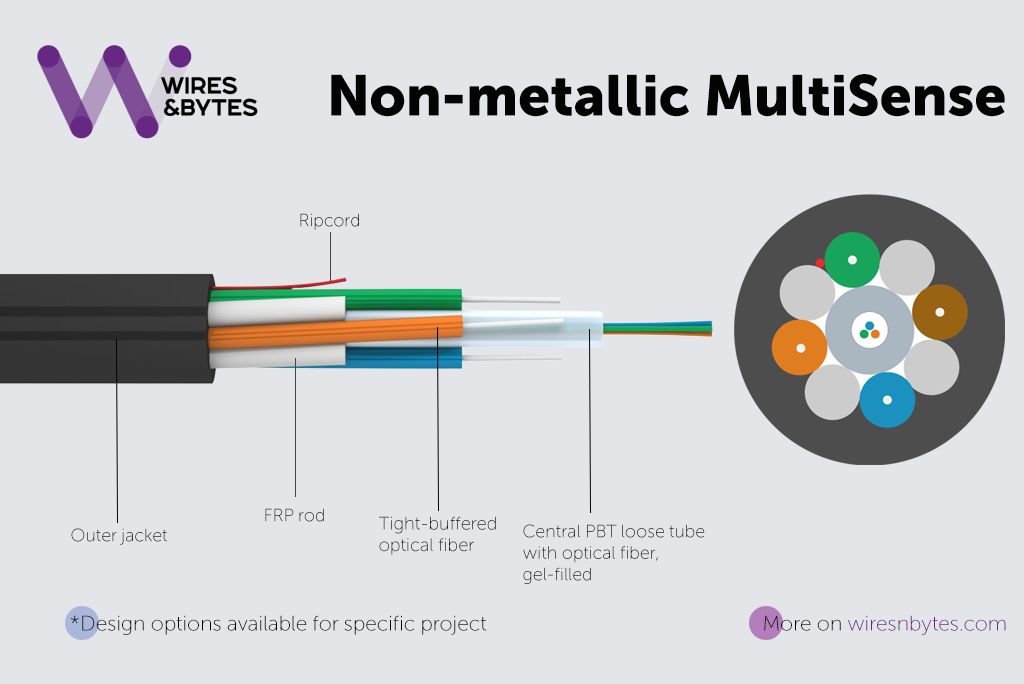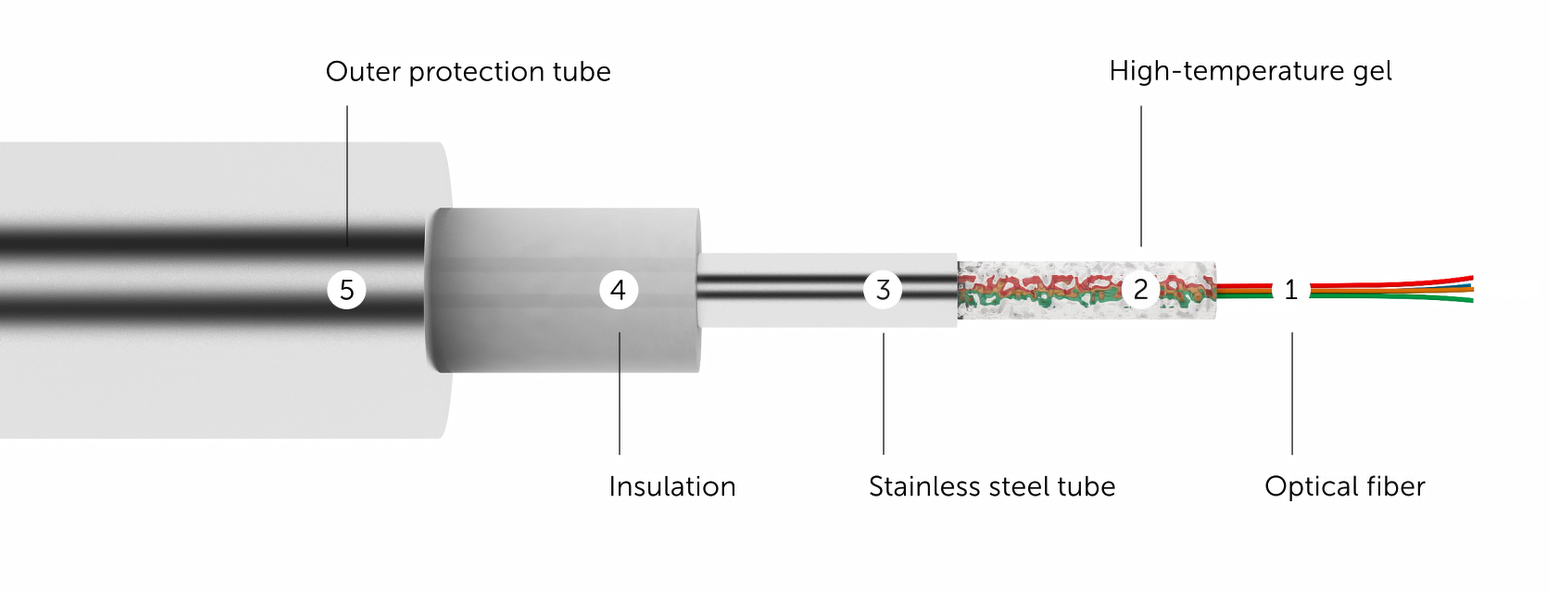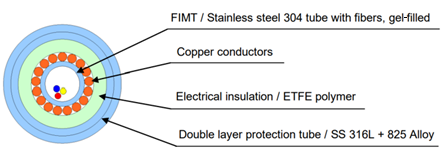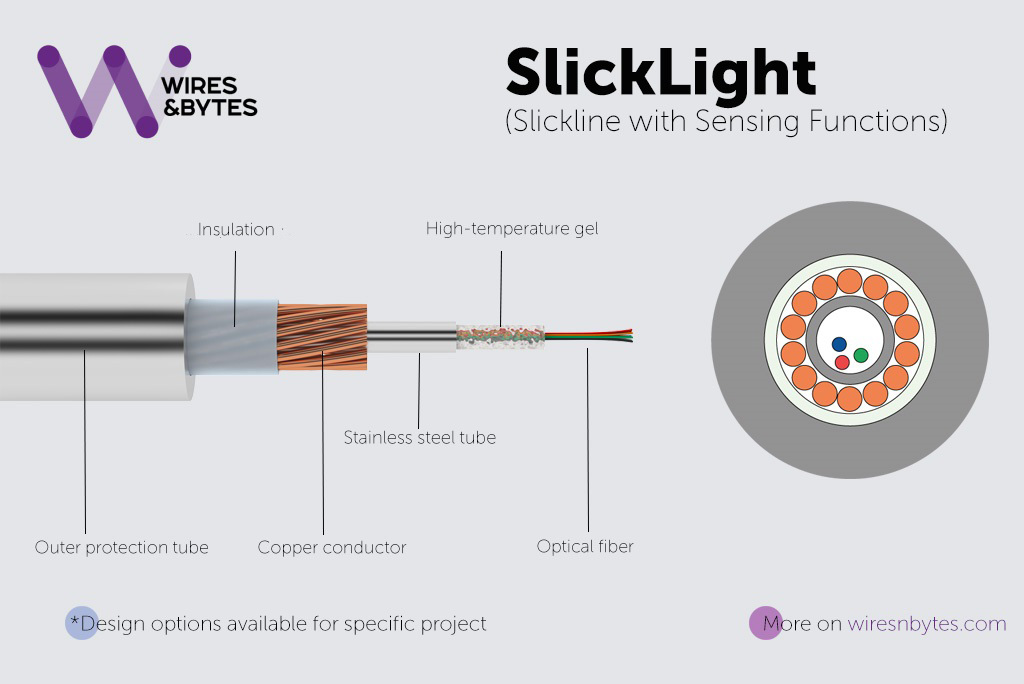Compact but multifunctional, Non-metallic MultiSense makes a change in the world of distributed sensing.
Despite its considerably small size and low weight, it is able to support all types of DFOS technologies and deliver multiple measurements. You might have already seen our Metallic MultiSense, but today let’s take a look at this design.

Non-metallic MultiSense is a combination of a gel-filled central PBT loose tube with optical fibers freely placed inside with 4 tight-buffered optical fibers, FRP rods, and outer jacket.
Please note that we design cables based on our customers’ specific technical requirements. In case of Non-metallic MultiSense besides any other requirements, the standard lay length may also be changed according to the project needs.
If you are interested in MultiSense and would like to learn more about it, please send an inquiry via website.
Wires&Bytes will commission a new production line to provide thick-wall tubes for our cables starting this autumn.
This is the culmination of design, technology, and investment targeted to meet our market and customer demands for longer, stronger, more reliable, and cost-competitive cables. We have worked closely with machinery suppliers to develop a state-of-the-art production line including forming the tube, superior welding technology, and quality control features. The new technology will offer cables which slick, gas-tight, and better sealing process on well head characteristics.
Take a look at our animated video to explore the thick-wall steel encapsulation tube design in detail (overall OD = 4.00mm with wall thickness of outer encapsulation around 0.8mm).
👉 If you haven’t had a chance yet, read our article about the distinguished features of the thick-wall small diameter steel encapsulation tube.
👉 Contact us for details on how this technology can improve your well logging experience, increase your ROI, and reduce TCO (Total Cost of ownership) at the same time.
Please let us know how we can help you to implement it in your location.
20 Jan 2021
Today’s oil and gas industry challenges require companies to deploy the most up-to-date technologies or upgrade the current ones as an alternative to the traditional mechanical wireline services.
Standard slickline servicing for the oil and gas industry can provide an effective well maintenance by deploying and manipulating the downhole tools. For many decades, slicklines and wirelines are used in well interventions that provide data with limited accuracy and acquisition frequency. The results depend very much on the skills of the operator and the quality of used tools. With the introduction of new disruptive technologies, these limitations have now overcome, for example, with the introduction of fiber optic (FO) slickline — the slickline/wireline becomes a distributed sensor along the whole length hence turning the full length of the slickline into a dense chain of passive segments, each one transformed into measurement gauge sensitive to external perturbation and physical quantities, detecting and measuring temperature, sound/acoustic, strain and pressure.
Wires&Bytes, which is at the forefront of the technology, have looked ahead and developed and offer FO slicklines and FO wirelines based on advanced fiber optic distributed sensing technology, DFOS. Wires&Bytes slickline tracks and monitors well activities delivering cost-effective data from the downhole allowing to make the quickest desicions for operators and owners, in many cases at wellsite.
The timely availability of well health information is critical to the oil and gas companies, where decisions hinge on the availability of useful data to implement it quickly and efficiently. The DFOS based slickline and wireline is an efficient and reliable tool, saving time and operating cost to the well operator, providing real-time information from the wells through an intelligent monitoring and allowing to identify and rectify issues and flaws in a timely manner.
Are you ready for advanced fiber optic sensing for precise well data at the speed of light? Let us know all your requirements and we will provide you with the monitoring solutions which are reliable, cost-effective and would increase your Return-on-Investment (ROI).
For further read, please go for Wires&Bytes “Slickline Measurements: The Future is NOW!”.
17 Dec 2020
In autumn 2021 Wires&Bytes starts a new chapter in steel tubing and will introduce thick-wall steel encapsulations mill while keeping the production efforts and related costs low. Predicting possible thoughts on the topic, our today’s post addresses the questions such as what the distinguishing features of thick-wall tubing are, and what benefits it brings to the customers.
The fact is that we increasingly receive the following requirements from the clients:

To tackle these challenges emerging from various applications Wires&Bytes has been closely working with machinery suppliers developing advanced welding techniques for improved steel encapsulation especially addressing small outer diameters and long lengths.
The result is a new mill tested and proved in the EU labs now planned for commissioning and putting into operation this autumn. So more posts in the future addressing this thick-wall steel encapsulation technology are planned and your comments and questions are welcome.
09 Dec 2020
With the availability of fiber optic and optic/electric slickline there are multiple new services that can be offered using existing idle assets. Fiber optic measurements offered by these slicklines provide wellsite answers and allow immediate optimization of production and clearly identify production problems, thus allowing customers to develop and implement an economic plan.
SLICKLINE CAPABILITIES
Fiber Optic Cable

Wellbore integrity (DTS/DAS)
Production monitoring (DTS/DAS)
Frac monitoring
Seismic profiling
4,6 mm (0.181 inches)
Working load limit — 2130 lbs
Electrical/Optical Cable

Well integrity with dual measurements
Electric line services
Advanced logging depends on power/telemetry requirements
Tractor in horizontal wells
Plus all fiber optic per fiber cable
4,8 mm (0.189 inches)
Working load limit — 1110 lbs
No grease injection required
👉 Use fiber optic slickline to put your idled assets back to work providing a technical solution for today’s production challenges.
Contact us for details.
We strive to develop market-driven and fit-for-purpose cables for the O&G industry. With innovation and shared dedication, we integrate advanced features in our cables, we aim to enhance our customer capability for intelligent surveillance and the ability to make decisions on site.
Recently, our fiber optic slickline with steel encapsulation has been deployed for a downhole well trial in Europe. The fiber-enabled slickline was successfully tested on the wellsite, providing DAS/DTS data as well as rapid visualization, manipulation, and integration of DFOS information with other well data.
The customer used their existing crew winch and pressure control equipment minimizing the need for additional crew and hardware. The DFOS data from the slickline can now be fully integrated with other customer’s services, enabling them to offer a comprehensive surveillance package to operators.
Our engineers meticulously test these slicklines for mechanical and optical standards, making sure they meet stringent requirements for the downhole harsh environment. These slicklines are also available in hybrid version, making it easy for customers to obtain optical test data along with running their electrical PLT tools.
Please contact us for details about the technology, how it can enhance your production and how we can support you in implementing it in the most cost-effective way.
➡️ Explore our slickline technology to learn more.




Our industry tends to think of slickline as a low tier option to make largely mechanical changes to the well later in its life. With the development and continuous improvement of memory tools there has been an ever-increasing role of slickline to deploy memory tools and later retrieve the information for analysis and interpretation.
We believe we are on the verge of a significant change in the way slickline is used and perceived. The evolution of slickline started with the first fiber optic slickline (~2010) when a Distributed Temperature survey (DTS) was deployed from a slickline drum into wells to measure flow profiles and do gas lift optimization. That huge step turned the entire line into an instrument which measured temperature along the full wellbore in real time. We saw that the performance of the reservoir was not static and gas lift valves chattered, opened and closed and rarely functioned exactly as designed.
Fast forward to today where Distributed Temperature Surveys (DTS), Distributed Acoustic Surveys (DAS) and an electrical signal can all be built into a single 4.8 mm (0.189 inch) or smaller line.

The possibilities are endless:
— Depth correlation via traditional gamma ray collar locator tools
— Flow profiles using DTS and DAS to give quantitative flow from perfs in non-horizontal wells
— Injection profiles from warm back data
— Leak detection using DAS and DTS
— Gas lift monitoring of the entire system at the same time – no station stops at a moment in time
— DAS to monitor for microseismic events from a nearby frac well to get frac height
— DAS to monitor strain and microseismic from an offset well for frac growth and prorogation
This new slickline technology combined with easy-to-use software and acquisition units will change the slickline industry to one where complex well analysis can be done in real time from the wellsite. Gas lift wells are run at the optimum production rate, frac analysis and modeling can be verified and improved for the local geological impacts.
Contact us for details on how this technology can improve your production and how we can implement it in your location in a cost-effective way to get answers quick.
Over 360 km of Wireline design WireCompoJack have been deployed and successfully operating at oil fields of one of Oil & Gas operators in Russia.
The cable provides connection of the surface interface unit with downhole measuring systems, lowered into the well.
Downhole measuring systems provide real-time monitoring of reservoir pressure and temperature at the pump intake. Thanks to this, the well operation modes are optimized.
All W&B cables pass the necessary qualification tests before delivery and show high operational reliability. Successful experience in the development and implementation of this type of cables allowed expansion of the Wireline family designs for Oil & Gas industry.
Wires&Bytes introduces downhole slickline cables for the Oil & Gas industry
All Oil & Gas operators need access to data for reservoir management. Common applications are well integrity, well performance and well optimization. Leaks in the system can cause environmental expenses, inefficient artificial lift systems and costly unplanned workovers. These are difficult to detect and locate using conventional single point measurements.
The advent of Distributed Fiber Optic Sensing (DFOS) measurements allows operators to monitor the entire well length in real time for the duration of the survey which makes DFOS uniquely suited to detect hard-to-locate well integrity problems and to efficiently optimize gas lift systems. A key enabler to make real time DFOS measurements is a reliable fiber optic slickline. Together with the appropriate surface interrogation units, effective data processing and visualization software a fiber program can improve profitability.
A number of service providers are addressing fiber deployment issues specifically lowering the base cost which today limits the use of fiber optic technology. Advanced service providers are utilizing new low cost slickline deployment techniques which leverage existing infrastructure and require very little in the way of additional skills for technicians.
Wires&Bytes introduces a range of downhole hybrid slickline cables for application in coil tubing and well logging. These robust and retrievable cables, which can be exposed to the downhole environment including H2S and high temperature, are made of highly corrosion-resistant stainless steel wires. These cables are designed to have high breaking strength and can be used to perform for years of service.
SlickLight cable designs are available in the following configurations:

This all-optical design comes with a range of fiber options, size, weight and rated breaking strength up to 7900 N. These cables are marketed with max deployment length of 5.0 km (16.400 ft).

This heavy duty SlickLight cable is targeted for long and deviated wells with max rated breaking strength of 15800 N and max deployment length of 8.3 km (27.200 ft).

A hybrid version, which incorporates both optical fiber and copper. The optical fiber is used for DFOS measurement while copper is used for power and communication for electronic tools and tractors. Max rated breaking strength is 8200 N and max deployment length is 4.7 km (15.400 ft).
Important! Mechanical performance of fiber can be measured in our fully equipped lab according to your specifications or requirements.